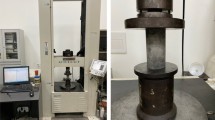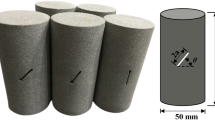Abstract
The mechanical properties and behavior of coal rock under both static and dynamic loading rates are of importance in the coal mining practices. In this study, both quasi-static and dynamic uniaxial compression tests are conducted on coal rock, considering the bedding directivity of coal rocks using a MTS hydraulic servo-control testing machine and split Hopkinson pressure bar (SHPB), respectively. The attained strain rates range from 10−5 to 10−2 s−1 for static tests and 20 to 100 s−1 for dynamic SHPB tests. For dynamic tests, pulse-shaping technique is utilized to achieve dynamic force balance and thus validate the quasi-static data reduction. A high-speed camera is used to capture the failure process in SHPB tests. The characteristics of failure mode, fracture strength, energy dissipation, and fractal dimension are investigated. A significant strain-rate-dependent behavior of coal rock is revealed, and the compressive strength, elasticity modulus and energy consumption increase with increasing strain rate. The bedding effect on the coal behavior at static strain rate is more prominent than that at dynamic strain rate. The measured strengths along different bedding directions exhibit distinct variations, featuring significant anisotropy. In addition, a sieving statistics analysis of the recovered fragments depicts obvious fractal; and the fracture dimension can be correlated to the fractal energy dissipation.




















Similar content being viewed by others
References
Abdikan S, Arikan M, Sanli FB et al (2014) Monitoring of coal mining subsidence in peri-urban area of Zonguldak city (NW Turkey) with persistent scattered interferometry using ALOS-PALSAR. Environ Earth Sci 71(9):4081–4089
Cai M, Kaiser PK, Suorineni F, Su K (2007) A study on the dynamic behavior of the Neuse/Haute-Marne argillite. Phys Chem Earth 32:907–916
Chen Y, Azzam R, Wang M (2011) The uniaxial compressive and tensile tests of frozen saturated clay in Shanghai area. Environ Earth Sci 64(1):29–36
Dai F, Huang S, Xia K (2010) Some fundamental issues in dynamic compression and tension tests of rocks using Split Hopkinson pressure bar. Rock Mech Rock Eng 43(6):657–666
Dai F, Xia K, Zuo J, Zhang R, Xu NW (2013) Static and dynamic flexural strength of anisotropic barre granite. Rock Mech Rock Eng 46(6):1589–1602
Daniel J, Moore LD (1907) The ultimate strength of coal. Eng Min 10:263–268
Fairhurst CE, Hudson JA (1999) Draft ISRM suggested method for the complete stress-strain curve for intact rock in uniaxial compression. International Society for Rock Mechanics Commission on Testing Methods. Int J Rock Mech Min 36(3):281–289
Frew DJ, Forrestal MJ, Chen W (2001) A split Hopkinson pressure bar technique to determine compressive stress-strain data for rock materials. Exp Mech 41(1):40–46
Gaddy FL (1956) A study of the ultimate strength of coal as related to the absolute size of cubical specimens tested. West Virginia Polytechnic Bulletin 112:1–27
Gray GT (2000) Classic Split-Hopkinson pressure bar testing. Mechanical testing and evaluation. ASM Int Mater Park 2000:462–476
Hirt AM, Shakoor A (1992) Determination of unconfined compressive strength of coal for pillar design. Min Eng 292:1037–1041
Holland CT, Gaddy FL (1956) Some aspects of permanent support of overburden on coal of the beds. In: Proceedings of the West Virginia Coal Mining Institute, pp 43–46
Hong L, Zhou Z, Ying T et al (2009) Energy consumption in rock fragmentation at intermediate strain rate. J Cent South Univ Tech 16:677–682
Khandelwal M, Ranjith PG, Zhu Pan et al (2013) Effect of strain rate on strength properties of low-calcium fly-ash-based geopolymer mortar under dry condition. Arab J Geosci 6(7):2383–2389
Kolsky H (1953) Stress waves in solids. Clarendon press, Oxford
Lagny C (2014) The emission of gases from abandoned mines: role of atmospheric pressure changes and air temperature on the surface. Environ Earth Sci 71(2):923–929
Li XB, Lok TS, Zhao J, Zhao PJ (2000) Oscillation elimination in the Hopkinson bar apparatus and resultant complete dynamic stress-strain curves for rocks. Int J Rock mech Min 37:1055–1060
Liu X, Zhang R, Liu J (2012) Dynamic test study of coal rock under different strain rates. J China Coal Soc 9:1528–1529 (in Chinese)
Medhurst TP, Brown ET (1998) A study of the mechanical behavior of coal for pillar design. Int J Rock Mech Min 35(8):1087–1105
Olsson WA (1991) The compressive strength of tuff as a function of strain rate from 10−6 to 103 s−1. Int J Rock Mech Min 28:115–118
Turcotte DL (2002) Fractals in petrology. Lithos 65(3–4):261–271
Unrug KF, Nandy S, Thompson E (1986) Evaluation of the coal strength for pillar calculation. Trans SEM AIME 280:2071–2075
Wasantha PLP, Ranjith PG (2014) The Taguchi approach to the evaluation of the influence of different testing conditions on the mechanical properties of rock. Environ Earth Sci 72(1):79–89
Wasantha PLP, Ranjith PG, Shao SS (2014) Energy monitoring and analysis during deformation of bedded-sandstone: use of acoustic emission. Ultrasonics 54(1):217–226
Xie H, Gao F, Zhou H et al (2003) Fractal fracture and fragmentation in rocks. J Disar Prev Mit Eng 23:1–10 (in Chinese)
Xie H (1996) Fractal—Rock Mechanical Introduction. Science Press (in Chinese), Beijing
Zhang M, Shimada H, Sasaoka T et al (2014) Evolution and effect of the stress concentration and rock failure in the deep multi-seam coal mining. Environ Earth Sci 72(3):629–643
Zhou J, Chen X (2013) Stress-strain behavior and statistical continuous damage model of cement mortar under high strain rates. J Mat Civ Eng 25(1):120–130
Zhou Z, Li XB, Ye Z, Liu K (2010) Obtaining constitutive relationship for rate-dependent rock in SHPB tests. Rock Mech Rock Eng 43(6):697–706
Acknowledgments
The authors are grateful for the financial support from the National Program on Key Basic Research Project (No. 2011CB201201, No. 2015CB057903) and the financial support from the National Natural Science Foundation of China (Nos. 51374149, 51204113,51134018).F. Dai acknowledges the support of the Program for New Century Excellent Talentsin University (NCET-13-0382) and Youth Science and Technology Fund of Sichuan Province (2014JQ0004).
Author information
Authors and Affiliations
Corresponding author
Rights and permissions
About this article
Cite this article
Liu, X., Dai, F., Zhang, R. et al. Static and dynamic uniaxial compression tests on coal rock considering the bedding directivity. Environ Earth Sci 73, 5933–5949 (2015). https://doi.org/10.1007/s12665-015-4106-3
Received:
Accepted:
Published:
Issue Date:
DOI: https://doi.org/10.1007/s12665-015-4106-3




